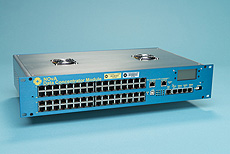NOvA data concentrator modules near completion
 |
The NOvA data concentrator module collects and organizes all the particle interaction information generated inside the detector. Engineers are completing the design and testing of the system. Photo: Reidar Hahn
|
News on Fermilab's NOvA experiment has largely focused on the assembly of the enormous blocks that make up the football-field-sized particle detector in Minnesota. But elsewhere in the NOvA collaboration, engineers have been diligently plugging away at a more hidden-away part of the detector, a component without which the giant device would never be able to intelligibly reveal what it sees.
This crucial component is the circuitry and computer code that make up NOvA's data concentrator modules, or DCMs. Now, after several years of design work and many months of testing and prototyping, engineers are completing the system. Nearly all that remains is for the modules to be installed onto the NOvA detector blocks as they, too, are installed.
"Many people worked hard to develop a DCM system we expect to run very smoothly," said Fermilab's Ron Rechenmacher, who led one of the DCM hardware-software integration efforts.
The NOvA DCM is a key component of the detector's data acquisition system, which is responsible for collecting and organizing all the particle interaction information generated inside NOvA's two detectors. When a particle interacts inside the detector, its energy is transmitted through the detector's fiber optic system as light signals, which get converted to digital signals by electronics boards, travel through the DCMs and eventually make their way to the larger data acquisition system. The electronics boards and DCM together convert the signals into language that experimenters can later analyze.
NOvA's DCM system comprises about 180 modules. Each of these custom modules, about the size of a briefcase, attaches to the detector. One hundred sixty-eight of them are assigned to NOvA's far detector in Minnesota, and a dozen or so belong to the smaller near detector at Fermilab.
To minimize costs and facilitate data taking, the DCM team worked to fit as many data channels into a module as reasonable. For the NOvA detectors, that meant arranging 64 channels and all their tiny, associated circuit pathways and elements on an expansive circuit board—an arrangement that invited difficulties in fabrication but that the group nevertheless successfully achieved.
Building a DCM also involved developing software for the system's processor. Working within the limits of the selected processor's power, Fermilab software engineers worked to accomplish more with less, economically writing code so the processor could not only handle the data collection, but also deftly perform detector diagnostics and calibrations.
"If you need every last bit of performance, that's when you need to get the expert coders in there to really look at every routine and make sure it's very efficient," said hardware designer Rick Kwarciany.
Having rigorously put the DCM through its paces, the team is confident that it will do its job well and won't bring any unwanted attention to itself.
"It's always the goal to set things up so well that, five years from now, everyone's completely forgotten about us," Rechenmacher said.
Rechenmacher and Kwarciany credit the outstanding work by software and hardware teams for developing DCMs that will make data taking effortless for NOvA scientists.
"The collaborators have been helpful and easy to work with," Kwarciany said. "It's an excellent experiment to work on."
—Leah Hesla
|